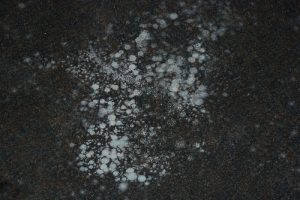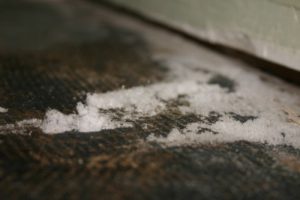What is White Mold?
There are many different types of mold and they come in different colors. In this article, we are discussing the white mold. While many seems to think that it may not be the most dangerous, it is important to mention that all molds can cause different health issues. Also, the presence of mold in a house can be a sign of humidity and can be responsible for damages to the structure of the house.
As we know, it is a combination of temperature and a level of humidity that allow mold to grow. And during the process, it may go through various colors. As the spores are responsible for the mold color, it will look white before it start producing them. Therefore, even black mold may first appear white.
Some may say it’s not important to know which type mold you have because it should not be there at all, period. That is a valid point view. But since some molds are more dangerous than others, it may be important to distinguish them in order to take the appropriate remediation process.
Is White Mold Dangerous?

Whatever the color of the mold, there are risk issues for your health. The list of common mold exposure symptoms is pretty exhaustive. Allergies, bronchitis, chronic sinus infection, difficulty breathing and skin rashes are a few sample of the risk of living in a white-mold-infested house.
Other common symptoms linked to white mold are:
- asthma attacks
- bronchitis
- chronic sinus infections
- chronic sore throats
- difficulty breathing
- exhaustion
- general malaise
- hives
- migraine headaches
- pneumonia
- skin rashes
The biggest problem with mold in general is the spores that are invisible and floating in the air. If you miss any signs of mold presence, you may not realize that you have a mold problem in your home and keep inhaling mold spores. The people at risk are kids and adults with breathing issues and asthma.
Where Does White Mold grow?
White mold can grown on various surfaces such as organic material, wood, concrete, carpets and drywalls. That is why is not uncommon to find white mold in different places such as walls, floors, ceilings or any other places where the condition for mold growth are present (temperature and humidity level). Typical places where white mold is found are attics, basement and crawlspaces.
How Do You Find White Mold?
There is a couple of ways to find to find white mold:
- By looking for it. Start with the places where you usually find molds. As mentioned earlier, attics, basement and crawlspaces are a good place to start. Sometimes, you won’t see the mold but some symptoms such as wall & ceiling discoloration, dampness, mustiness or water damage. Something as simple as foggy windows during winter or bad air circulation in your bathroom can provide enough moisture for mold growth.
- By smelling it. While it may be a subjective test, you can find mold by locating where the moldy smell come from. As soon as you think you smell something, start searching for evidences. Look for a second opinion and remember that mold may grow on a spot that you can’t see (behind drywall for example). However, it’s important to notice that no moldy smell does not mean no mold presence in the house.
Be Careful Not Too Confuse White Mold With Efflorescence!

Efflorescence is a deposit of salt when water evaporate on surfaces such as brick, concrete, stone or stucco. That crystalline deposit, that may look like white mold, will not cause any health issues neither will it spread or grow (since it is not a fungus).
The problem now is to identify the white substance that you discovered. There are a couple of ways to determine the nature of the substance:
- If the substance is found on a surface other than concrete or masonry surface (brick, concrete, stone or stucco) then it is probably white mold.
- Since efflorescence is simply a deposit of salt, sprinkling some water on it should dissolve it.
- The texture of efflorescence is more like powdery compared to the fuzzy appearance of white mold.
If you still can’t determine the nature of the substance, you still have two options:
- You may want to have a professional mold inspector over and confirm if it is mold or not. There might be a certified mold inspectors in your area. If it is not the case look for an experienced company in mold removal.
- If you are more like a do-it-yourself type of person, you could find test kits. Be careful of the test kit that you buy as they are not all created equal. Do cut corners to save a couple of bucks. Make sure the test kit has a great track record. If you doubt the results, it may be best to have a second opinion by having a mold inspector over.
What to do if you have White mold?
There are many options if you find white mold in your home:
- You may call a licensed mold removal company to take care of it. They will be able to assess and recommend a solution on how to get rid of it. They should also be able to locate the origin of the mold growth. The cost will be based on how severe is the infestation.
- If you are a do-it-yourself type of person, you could buy a mold removal kit and follow the instructions on how to proceed. Just like the test kit, you should only purchase the removal kit from a reliable company and avoid cutting corners to save money.
- You may found a homemade recipe for a solution to kill white mold. Educate yourself on the proper way to do it and proceed.
It is important to find the origin of the problem in order to avoid further mold growth in your house. Furthermore depending on the severity of the infestation, it may be best to use a mold removal company instead of a do-it-yourself kit or a homemade solution. Remember that all mold (toxic or not) can cause serious health problems and allergies to you and your family.
If you decide to tackle the problem yourself (option 2 and 3) the basic steps should look something like this:
- Identify the source
- Quarantine the area to avoid spreading airborne spores during the removal process
- Protect yourself using safety gears such as glasses, gloves, masks and covers (hair and shoes)
- Finally proceed with the removal. Depending on the surface, you may have to clean and scrub (non-porous surfaces such as glass, metal, tiles…), or remove the material to replace it with a new one (porous material such as carpet, drywall, insulation…).
How to keep white mold away?
The best way to keep white mold away is by changing the conditions that allows its growth. It is crucial to keep the humidity level in your house below 60%. While the season and the area in which you leave will have an impact on the level of humidity in your house, ensuring that there is proper ventilation in general in your house but most importantly in the rooms where you may find humidity (bathrooms, basements, kitchen…) will make it difficult for the fungus to grown and flourish.
The rest is common sense, make sure are no water, wetness or dampness in your house due to leaking or rain infiltration. If there is any water damage, make sure to properly remediate and clean to avoid potential mold growth.
